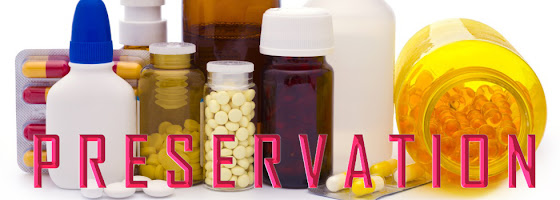Preservation of Pharmaceutical products l Study Pharma l
PRESERVATION OF PHARMACEUTICAL PRODUCTS
Preservation is process in which preservative chemical agents are used to improve or increase the shelf life of the pharmaceutical products by reducing the microbial spoilage or contamination by reducing the microbial growth.
Preservatives are the chemical agents that are used to preserve the products.
Preservatives are natural and synthetic chemicals that are added in products such as foods, pharmaceuticals, paints, biological samples, etc.
Preservatives are the chemical agents that are used to preserve the products.
Preservatives are natural and synthetic chemicals that are added in products such as foods, pharmaceuticals, paints, biological samples, etc.
IDEAL PROPERTIES:
1. Able to kill the microbes in the formulation.
2. Maintain the physical and chemical stability.
3. Not affect the therapeutic action of the formulation.
4. Should be tasteless and odourless.
5. Not be irritant.
6. Very effective at low concentration.
7. Non toxic in nature.
8. It should be compatible with other ingredients in the formulation.
Single preservative agent not used to preserve all types of formulation. Why?
Because single preservative agent may be effective or not effective on microbes depends on the properties.
Example: We use food preservatives to preserve foods, but if it is used in pharmaceutical products doesn't give effect on microbes that present in formulation because of different properties(Means, the main agent that kill microbes in pharmaceutical products are not available in food preservatives).
NEEDS FOR THE PRESERVATION:
1. To improve the shelf life of the products.
2. To kill the microbes and protect.
3. To stabilize our products.
CLASSIFICATION OF PRESERVATIVES:
1. Based on their Mechanism of action.
2. Based on Source.
1.Based on their Mechanism of action:
- Antioxidants:
Antioxidants are preservative agents used to prevents the microbial oxidation of the pharmaceutical products.
Microbial oxidation is degradation of the active ingredients.
Example: Vitamin E, Vitamin C, Butylatedhydroxyanisole (BHA), Butylatedhydroxytoluene (BHT).
Microbial oxidation is degradation of the active ingredients.
Example: Vitamin E, Vitamin C, Butylatedhydroxyanisole (BHA), Butylatedhydroxytoluene (BHT).
- Antimicrobials:
Antimicrobials are preservative agents used against gram +ve and gram -ve microbes which cause degradation of pharmaceutical products.
Example: Benzoates, Sodium benzoate, Sorbates.
- Chelates:
Chelates or chelating agents are preservative agents used to form complex with the ingredients of pharmaceutical products and prevents the degradation.
Example: Disodium, Ethylenediaminetetraacetic acid (EDTA), Polyphosphates, Citric acid.
2. Based on Source:
- Natural:
Natural preservatives are obtained from natural sources like plants, minerals and animal sources.
Example: Neem oil, Salt (NaCl), Lemon, Honey.
- Synthetic or Artificial:
Synthetic and Artificial preservatives are man-made. These are chemically synthesizes.
Example: Benzoate, Sodium benzoate, Sorbates, Propionates, Nitrites.
FACTORS AFFECTING PRESERVATIVES:
-Interaction with formulation:
Added preservative interact with any other ingredients in the formulation cause decrease its action.
Example: Many tablets additives cause problem in tablet preservation because of interaction of additives with the preservatives.
-Properties of preservatives/ Multiphase system:
Preservatives distribution should be proper or homogeneous in the multi phase system.
Example: Such as chemical like chlorobutol hydrolyse on unfavourable pH condition.
-Effect of containers:
If the preservatives are stick with packaging materials also responsible for reducing its preservation effect.
Example: Quaternary ammonium compound adsorb at the plastic and glass.
-Influence of pH:
pH of the many formulation affect the action of the preservatives.
Example: Quaternary ammonium compounds are more active on high pH .
Thank You





Comments
Post a Comment